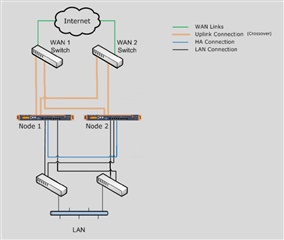Hi all,
I have a customer who has a SG330 running for several years now. He also has a 2nd SG330 that was planned to be used as a "cold standby" device. Since that doesn't make any sence I want to change the setup to an active-standby HA configuration. The cold standby device was reinstalled with the same firmware as the running devices.
What is now the best way to set up clustering. Should I import the config backup on the freshly installed device and reinstall the actual running before I enable clustering or does it make more sense to add it to the actual running device for some reason? I don't have any practical experience with UTM clustering yet.
The running device has two pppoe connections, I guess the best way will be to add 2 VLANs on the core switch for that where both relevant interfaces and the modem's interface will be in? Or is a "dumb" (desktop) switch the better solution? Is there anything to care about like pppoe timeouts or sth. like that?
This thread was automatically locked due to age.


